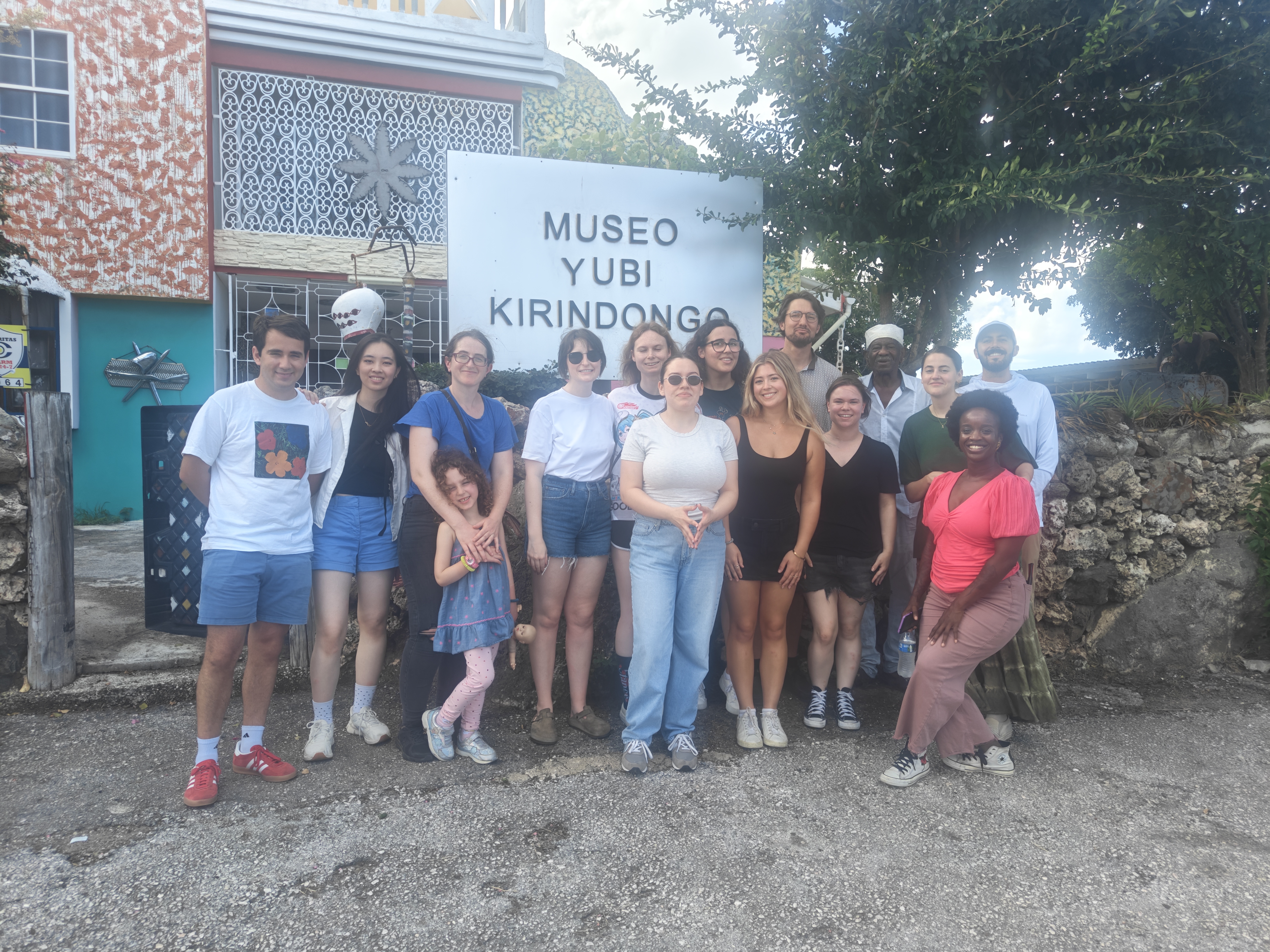
At the end of November in Fall Quarter 2024, 12 undergraduate and graduate students traveled with their Professor, Abigail Lapin Dardashti, to the beautiful island of Curaçao to explore Caribbean art and culture in person. All quarter long, they prepared for this journey by studying Caribbean art history from the pre-Columbian period to the present, focusing on movement and migration around the archipelago as well as local theoretical and artistic exchanges. For the trip, Professor Lapin Dardashti arranged lots of interesting educational activities that showcased the island and gave students a unique view of Curaçao.
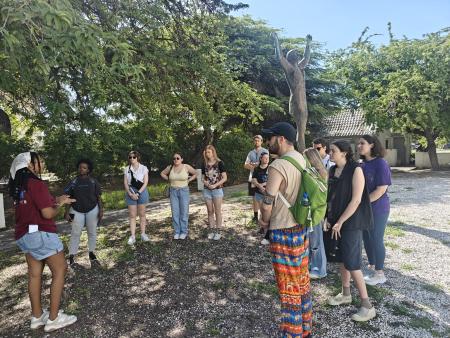
Students started the trip off with a tour of the Curaçaosch Museum, the oldest museum in Curaçao that has a display of furniture, textiles, paintings, a botanical garden, and more. The museum director, Judaline Cyntje along with the visual artist Jane Castillo, took students on a private tour of the special exhibit, Parade. Then, the group visited Instituto Buena Bista, a center of contemporary art in Curaçao that has art educational programming as well as an international artist residency program. The center is located on the campus of a mental health institute and has courses for patients as well as artists from the island. The students were able to tour the art school, museum, and studio with Afro-Curaçaon artist and co-director of the museum, Tirzo Marta. To round out the day, the group visited the 16th-century Jewish cemetery, where they could see the landscape of the Shell oil refinery.
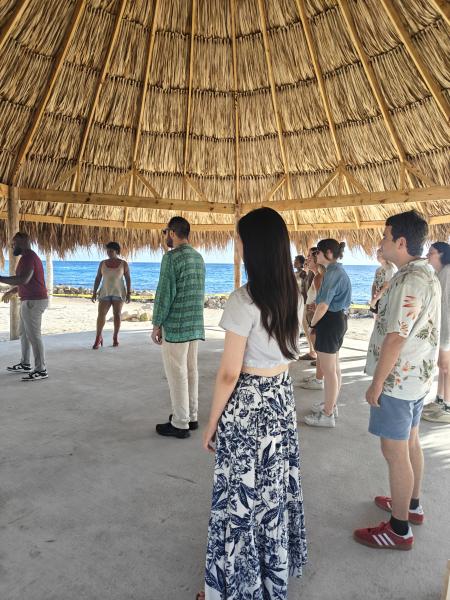
The next day, the group started off the morning by doing some experiential activities in the sea at the hotel. After lunch at the hotel, they got the opportunity to hear a lecture from Michèle Russel-Capriles, Chair of the Board of the Jewish Museum and Archive, and former active governor of Curaçao. Michèle discussed Jewish forced migration to the island and Jewish cultural production. In the afternoon, they attended a salsa class on the beach. In the evening, the group had a fish barbecue dinner at the hotel with music and had the chance to chat about the day’s fun activities.
On day four of the trip, the group visited Kas Di Plal’i Maishi Museum, which examines post-abolition lives and acts of resistance by people of African descent on the island. At the center of the museum sits an adobe house with a latched roof that was built in the late 19th century and shows the architectural techniques that Afro-Curaçaons developed over time. After that, the group did two art studio visits with Afro-Curaçaon artists Yubi Kirindongo, who primarily uses recycled materials for his art, and Omar Sling, who does a mix of painting, ceramics, recycled art, and sculptures.
After lunch, the students visited a sculpture garden at Aloe & Art Pos Salu, a public park that has sculptures made by local and international artists. Then, at the end of the day, the group did an art studio visit with Afro-Curaçaon artist Avantia Damberg, whose work explores the environmental consequences of the tourism industry as well as important Black figures related to the island who fought for equal rights.
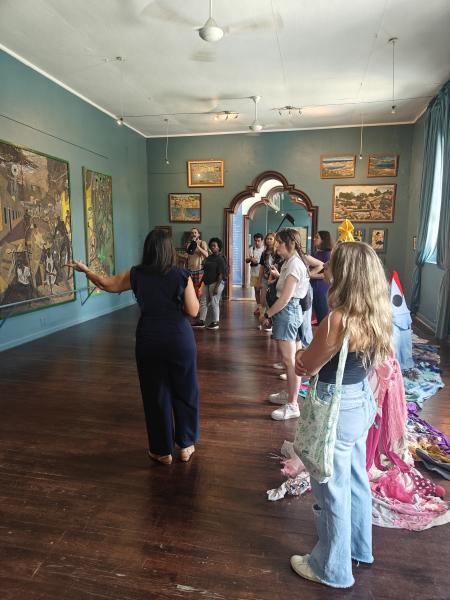
On day five, the group started off with a guided tour of Museo Kura Hulanda, the only museum on the island dedicated to enslavement, which includes artifacts and documents about the transatlantic slave trade, enslavement on the island, the Dutch East India Company, and oppression, torture, and resistance during the colonial period. Afterwards, the students took a tour of the old city in Curaçao, specifically looking at public art. In the afternoon, the group visited the Synagogue and Jewish Cultural Center, including a tour of the archives. This museum displays the history of Jewish people in Curaçao from 1634 to the present. Then, the students checked out the Mongui Maduro Museum and archive, which is a former plantation house and shares the history of the Sephardic Jewish Levy Maduro family. After looking around the museum, the students got to do a special visit to the Mongui Maduro Archives with museum director Lianne Leonra. Students viewed archival documents from the sixteenth century in the vault, which is usually closed to the public. To finish out the day, the group ate dinner at Villa Vis, a local fish restaurant that is right next to the sea.
On the last full day in Curaçao, the group got to tour the National Archives with deputy director Modianne Cathalina. They also got to check out the paper conservation lab there, which is usually closed to the public, and looked at the restoration of blueprints of the oil refinery. Then, they next visited the Landhuis Bloemhof, a cultural center that showcases Curaçaoan art, history, and nature, and Thorn Cathedral, a fascinating structure of art made from thorns that depicts that complicated history of Curaçao through the work of artists from the island. Afterwards, they visited the National Archaeological and Anthropological Memory Management Museum, the main cultural heritage center in Curaçao. Archaeologist Amy Victorina gave a tour of the museum storage area and showed some of the museum’s special objects to the group. Students discussed the ethical implications of archeological digs focused on Indigenous people on the island. The group’s last activity of the day was a visit to a colonial well in Fort Nassau, a fort built by Dutch colonizers in 1797.
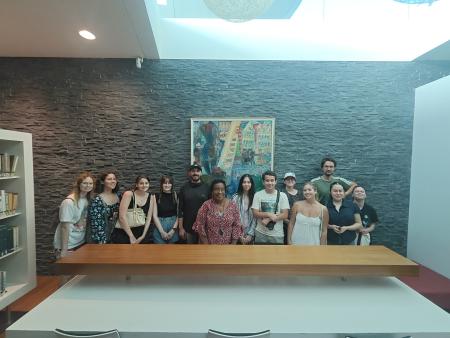
Overall, this trip to Curaçao provided an excellent experiential travel opportunity for these students, some who had never been abroad previously. Students were able to examine the textures, colors, and depth of Caribbean art in person, which gave them a fuller experience while studying it. In addition, students learned about field research, archives, and conducting interviews and studio visits with living artists. This trip was made possible through generous funding from the Steckler Family Initiative in Art History.
